Marketers are constantly seeking ways to solve brand inconsistencies. So, they’re always in search of marketing automation technologies. In fact, 75 percent of marketers said they use at least one marketing automation tool in their brand design processes.
With the average human spending 55 seconds on your content, making your posts click-worthy and engaging has never been more valuable.
That’s where Rocketium comes in. This tool helps you connect well with your audience by using the media they resonate with. Rightly so since it will be counter-productive to use video when your audience prefers banners and vice versa.
Key Takeaways from the Interview
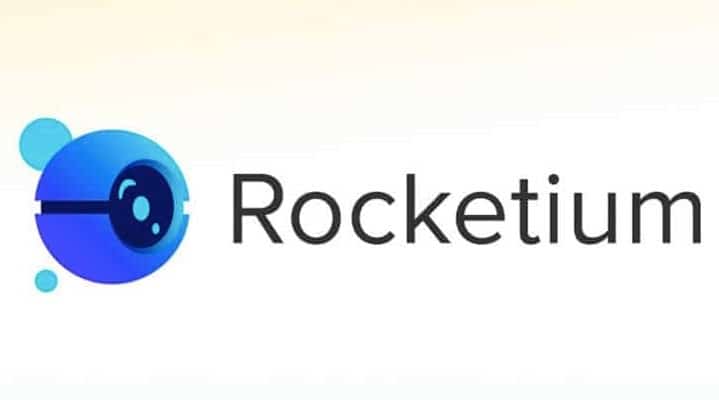
Some key points to note in the interview are:
- Solve today’s problems, add value to customers today and grow the business rather than live in the future and plan for futuristic things.
- You could have a lot of cool ideas, but if you don’t solve a customer’s problem today, no one would care. Even if your product is interesting or does a hundred things.
- Small businesses should focus more on solving distribution problems than creativity or having a good product
- Content marketing is about crafting the right messages.
- If you identify where your audience is spending time and advertise there, you’ll be maximizing your ad spend.
- Spend your ad budget only in channels that your users spend their time.
- Know the message that connects with your customers. Know the language they speak.
My Conversation with Satej Sirur

- Satej Sirur, CEO & Founder Rocketium.
1. Hello, please introduce yourself. Tell us about your professional experience?
I’ve been in the industry for about 17 years now, with a range of experiences spanning software engineering, software management, and product management.
And now I hold a leadership position at Rocketium.
My experiences have been in both startups and large enterprises in India and the US.
So, across the board, the team set up at Rocketium has been about some depth in some roles, as well as breadth across different kinds of industries.
I wouldn’t really say there’s any formula to being an entrepreneur. But this feels as close as it can get because you’ve got a chance to experience companies at different stages.
There are different types of cultures and roles. That’s something that I really enjoy.
And now as an entrepreneur, I get to put a lot of those learnings to use as well.
2. Rocketium started as a platform for people to share informative content in the form of mini-games. At what point did you feel the need to change your business model?

I’ll just go back in time a little bit, to tell you where this idea even came from.
When I was working at my first job at Microsoft, I used to play a lot at the game center.
I still do.
At that time, one of my favorite games was the Sims. The concept was that you could create characters that would live their life in any way you wanted them to.
What I really liked about that concept was that the characters that I made were always working on improving themselves and doing something about their lives.
That concept always stuck with me. Seeing that in a game I’m really motivated because of the gamification to help these characters improve their lives. What if an app could help everyone around the world improve their lives in some way?
Fast forward, almost ten years, when I was working at a cab aggregator similar to Uber and Lyft. I had the opportunity to continue with that company or pursue the idea that’s been in my head for ten years.
That was when I started that company. Without market study or talking to anyone about the business.
I never bothered asking “Hey! would you want something like this?” It was just something that I wanted to build and get out of my system.
As someone who likes to build products, I said, you know, what’s the worst that could happen. And the worst is that nobody cares and you keep building that thing.
But luckily, something interesting happened. When we showed it to a few people, some parts of the mini-game format that we had created looked like a video to them.
And because video was something that was booming at that time, Facebook, LinkedIn, Twitter. All of these platforms were nudging users to upload their videos. And those videos were getting a lot of traction.
So, they said if I can create games so easily, creating videos with your platforms should be much easier.
Can you export what you have as a video?
That’s when we got to work and repurposed our product and made it into a video creator.
3. You designed Rocketium to help users create impactful videos that resonate with their audience. What have you seen in making that transition? What lessons have you taken along with you from converting an interactive mini-game system to a video-focused platform?
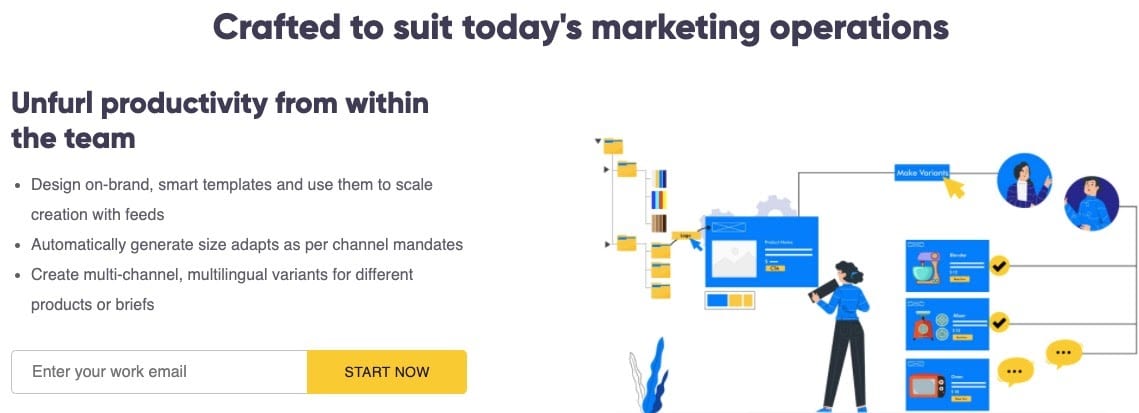
This reminds me of a conversation I had with my ex-boss.
While explaining some of the things I was doing to him, he said, “Hey, all of this is fine. This is the meat and potatoes, but where is the seasoning? Where is the next set of amazing new experiences that you’re going to create in the next five or ten years from now?”
That was when I told him, “It’s great to think about what’s going to happen five or ten years from now. But the world isn’t five or ten years from now. The world is today.
So, let’s solve today’s problems, add value to customers today and grow the business rather than live in the future and plan for futuristic things.”
So, I still believe that the game platform I built was a neat idea.
Somewhere, someday, somebody is going to build it and get value from it, but that wasn’t the right problem to solve for end-users at that time.
So, that’s the same thing here. We learned, and we continue to learn.
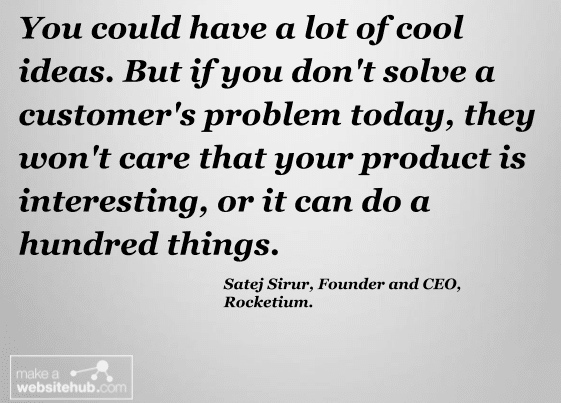
You could have great, cutting-edge technology. You could have a lot of cool ideas. But if you don’t solve customers’ problems today, they won’t care that your product is interesting, or it can do a hundred things.
In the last five years, we’ve built a lot of things that have been quite cutting-edge and ahead of the times. And as we pen down what we’ve built, we brought the problem down to something very direct. Especially things that people do on a regular basis.
That was really when our product started connecting with customers.
So today, we count some of the largest companies in the world as customers. Including some of the fastest-growing unicorns.
Even with videos, something interesting happened. Although everybody talks about video and how its consumption is growing, our growth really took off last year when we launched the capability to build images.
About 70% to 80% of companies that produce e-commerce apps, consumer apps, or the ads that you see actually use banners and not video.
So when we launched the capability that allowed customers to not only make a video, but also images, our growth really took off.
It wasn’t good enough that our product could help anybody make a video, or make it at a massive scale. Neither did it matter that it was multilingual or any number of jazzy things.
If they want to make banners, you have to give them banners. Otherwise, they won’t use your product.
So it’s about living in the present with your customers, solving the problems that they have, and that’s the lesson we continue to learn every day.
4. Some of the things you’ve said seem to really apply to small businesses. I know that you work with a lot of corporations and a lot of enterprises, but how can small businesses begin to take advantage of video right now? What opportunities are you seeing that small businesses are probably not taking enough advantage of?
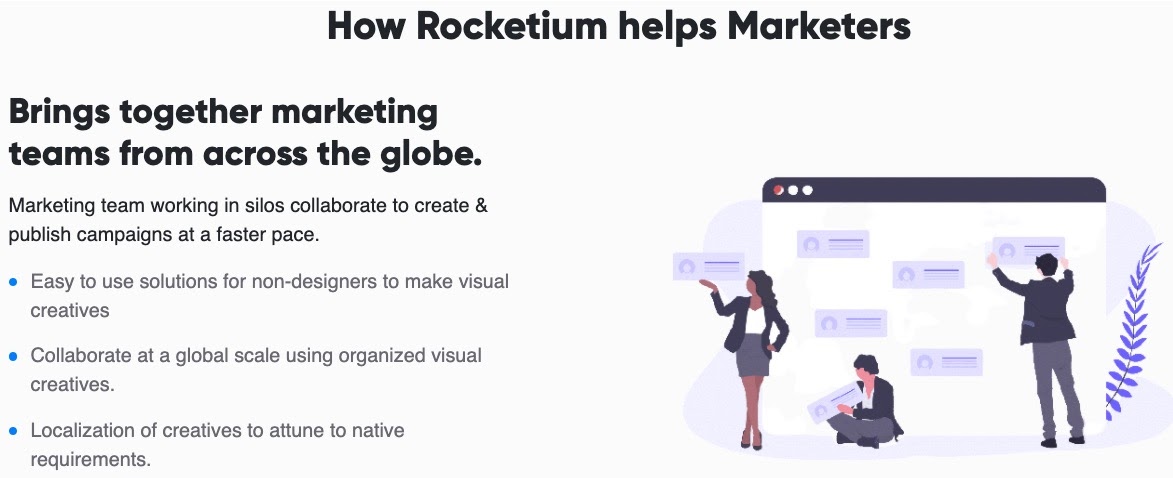
Being a small business, the problem really comes down to distribution. It’s not about creativity, it’s not about a good product. It’s about distribution.
How do I get in front of enough people so that a percentage of those people find me appealing enough to take an action?
With large businesses, not only do they have a large team to execute projects, but they also have a lot of money to spread the word about any video they make. Either through advertising, sponsored posts, hosting events and more.
So that’s really a challenge with small businesses. Your donors have to do much more work because you have far less money than what a large company would have.
So, it’s about crafting the right message, not really spraying and paying, which a large company could do.
I’m reminded of a recent article. The Head of Performance Marketing at Uber figured out that after doing a bunch of analysis, a lot of channels where they were pumping ad dollars weren’t really working.
And when they removed $150 million of annual ad spend completely, They found that the numbers weren’t affected at all. So, they were spending such a massive amount in useless places that didn’t deliver any results.
So, small businesses don’t have the luxury to spend even a few tens of thousands of dollars for wasted ads. They have to know their audience, where they hang out, what messages they connect, and keep experimenting.
It’s more about finding your competitive advantage. You have more understanding of the product and the market. And the business and the end-user, and you can be more creative and experiment more.
So, they should be experimenting more and spreading their ad dollars over fewer user segments and fewer messages. They don’t need to create a large number of ad campaigns to spread over multiple user segments. It’s just about spending money more smartly and being more creative in the messaging.
5. Are there specific actions you’d say that small businesses could take? Especially when it comes to distribution. Since you said they shouldn’t focus on spending a lot of money on ads, what would you suggest?
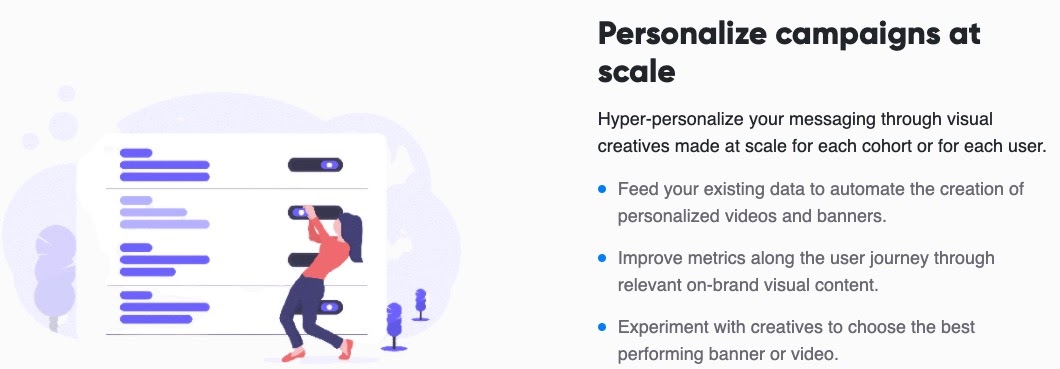
I can give a couple of tactical examples.
As I said earlier, you need to know where your audience is spending time.
So, if you know that a lot of them are actually spending time on TikTok versus, let’s say, on Facebook. You might want to spend time over there, even if everyone says they advertise on Facebook.
You could create a lot of good organic content. We see a lot of D2C brands going viral because of really simple videos that they are creating. Not a lot of high production quality.
I’m also reminded of a shoe brand that made really simple videos of pouring wine and doing all different things to their shoes. They were showing that it didn’t even get wet or dirty. The video was only ten-second, but it went viral.
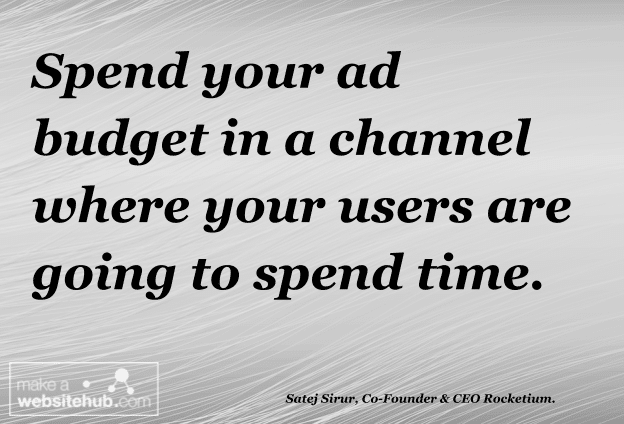
So, knowing what your audience connects with and where they’re hanging out, is where you should spend your attention. You don’t have to spend more ad dollars.
Try to understand what kind of messages your audience connects with. For example, if they speak Spanish, you want to make sure that your ads are in Spanish, not English.
You could get translators to make these kinds of ads and use the targeting options that ad platforms give you.
You also want to make sure that only those customers are seeing it.
So, it’s about being smart and spending your money where you’ll get the highest impact, and tailoring your message, brand designs according to what those people would like.
6. You said Rocketium started scaling last year when you discovered that you could use images. How were you able to realize that this would work with your audience?
The interesting thing is, a year before we were working with one of the largest e-commerce companies in Asia. As we were talking to them, they said, ‘Hey, video is fine. But have you considered doing banners? We do much more with banners than with video.’
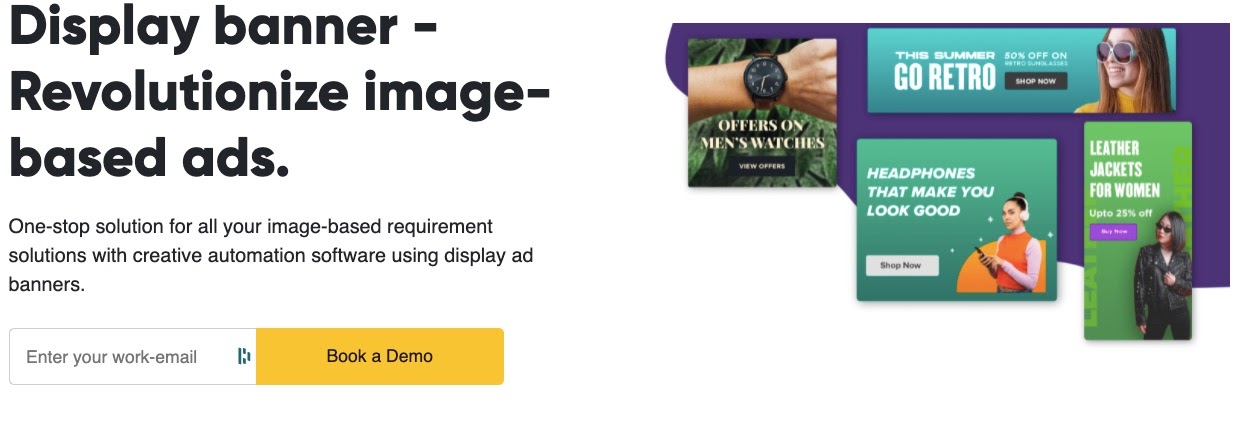
And originally in that meeting, I was aghast: ‘Guys! I’m coming to you talking about video. We’re talking about doing a deep partnership. Why are they asking about banners? Banner is old school, banner is no good.’
I was trying to convince them that they should be doing only videos because that’s what we did. Right?
That’s a classic thing where you are not really in love with the problem, you are in love with your solution. So I was trying to convince them to do a video and they kept talking about banners.
We went back to the team and put our heads together. Then we said, we could quickly adapt what we have into the image.
And when we talked to them, it was interesting. But, things didn’t go as far as we wanted. So, we shelved that project.
A year later, one of the largest e-commerce companies globally came to us with a similar proposal. Interestingly, they were talking to us about videos.
But when we understood what they actually did internally, we advised them not to do videos, consider doing images. So, we took out that shelved project and showed them a quick prototype, and that really connected with them.
So, we decided to run it by a few other e-commerce companies. It was a light bulb moment to have people say “absolutely.”
Although videos are also important, our apps, installed ads, in-app content, or push notifications use images much more than video. That’s when we really realized that that was the product that we should be working on.
So we took everything that we had adapted into different products, and we launched that last February. So it was more about listening to customers first and being obstinate. Not listening to them, then actually listening to them.
And eventually being a little more consultative with customers. Where, even if they have a certain need, we talked to them about all that could potentially happen.
So it’s that sort of push and pull that happens with your customers.
7. You started Rocketium with your partner. How and why did you make that decision to partner with Anurag Dwivedi?

I’ll admit that I’m a very judgmental person. Generally, I’m very pleasant and people like talking to me and I don’t get into confrontations with people. But, I’m always judging people.
I’m always judging my own actions because that’s what keeps me honest and performing in a certain way that appeals to my third person who’s always evaluating. Right?
And in that evaluation, a lot of people don’t really make the cut, including me.
So, Anurag is somebody who had a very high bar and met that kind of standard that this alter-ego of mine would always be evaluating.
So, when I found somebody like that, it was very clear to me. Only one or two people gave you that sort of comfort where you can trust them to get on this kind of journey.
Because it’s been five years since we started. And, we didn’t plan for five years at the beginning. We didn’t know how long this would be.
In fact, saying that it’ll be five years or ten years just sounds like a very long time, especially if you’ve been in the industry.
In his case, he was only out of school for about four or five years. So for him, it was a big decision. Likewise me. We were going to spend the same amount of time on this project that does not even exist.
So, it was more about
- Being comfortable with this person
- Someone who behaved in a certain way whether you’re looking at them or not
- You can trust them
- You have similar thought processes, and
- You agree on important points.
Although it’s good to agree, it doesn’t have to be on everything.
Even those disagreements are fun to talk about with him. And I also learn something new in that process.
I would say that was really what helped me realize that he’ll be a good partner to start the company with.
8. Your clients speak highly of your customized automation suite. Kindly take us through how it works for the sake of interested users who might be reading this interview?
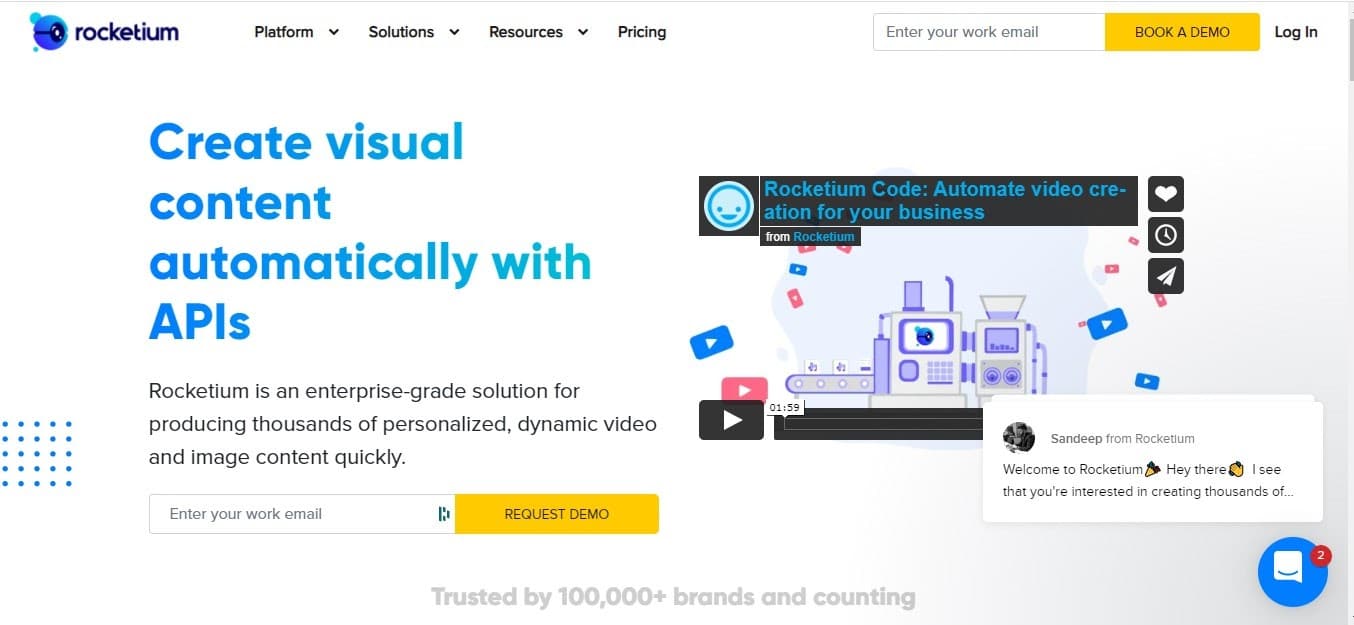
Today, the product has morphed into something quite large with many different pieces. But, let me maybe focus only on a couple of the important aspects.
At its core, we’re solving the problem of creative production. There are other pieces that are coming, but I won’t talk about them today.
The problem of creative production as it exists today is simple. Photoshop is a 30-year-old software, very powerful software built by amazing people. Most of the amazing creatives that you’ve seen today, whether it’s print or outdoors or digital creatives have been created with Photoshop.
And when I say Photoshop, I’m talking about generally the rest of the Adobe creative suite. After Effects, Premiere Pro, things like that.
Now, the challenge with that is that they were made 30 years ago for a very different world. Where one creative had to be this amazing, outstanding, piece of art that you had to create.
But today, what has happened is that the speed of execution has changed a lot.
Whether you’re a small business or a large enterprise, your customers are spending time on multiple different platforms.
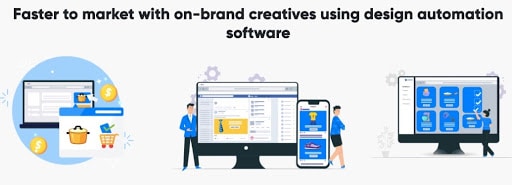
This means at the least that you’ll have to adapt your single creative to different sizes to meet the requirements of the different platforms.
Not only that every platform has slightly different nuances about how creative should look.
- Some expect it to have a button on it and some don’t
- Some would say more text versus less text
- Some would prefer video and some prefer images
- Some work with audio, some without audio.
So a lot of such nuances are there. Then these businesses have a large number of products. They have many users for which they might want to create multilingual content and things like that.
So all in all, what ends up happening is that the scale of creative production within companies has gone up massively.
But what hasn’t changed is who is making those creatives. It’s still designers within the company or within agencies while creating it.
Marketers today, still go to a design team or go to an agency and say, we want creatives. They would make it and give it back. The only thing that’s changed is scale.
The frequency has gone up and the time in which they wanted has gone down. They want it “yesterday.” They can’t think of a campaign today and wait two weeks for the result.
So, it’s not the fault of marketers, designers, or Adobe. Nobody’s happy in this workflow.
What Rocketium’s team did was take the best of all of these software and created a more modern workflow. It helps these marketers and designers work better together and scale the creative production. So the ultimate is that they’re able to serve their end-users.
Whether it is through advertising or in-app, or push any message that goes out from a business. They’re able to tailor it more towards the end-users and do it at a much, much faster pace.

So the way it works is designers are able to templatize their creatives.
As an example, if you see any banner ad, or if you see a video, you’ll see that it would have the same four or five elements for every brand.
It could be:
- A product image
- Some sort of message
- A video that’s playing, or
- A call to action
Once that template has been made, they’re able to either take an existing creative from Adobe tools.
Import it, or make it from scratch with Rocketium. Then open it up to end-users. These could be marketers or other team members who are using this product.
The simple user interface will allow you to replace the placeholders within it. So instead of this product, they put up another product and replace the call to actions with appropriate ones.
Rocketium really helps you set up. If you have any sort of a data feed, you can import that and hundreds, or even thousands of creatives you could make at one shot. We also have other AI-powered features like translation, background removal, automatic content suggestion and more.
All these help to speed up the process even more. And it’s something that you couldn’t have done even with more people in your team.
Then there’s collaboration and automatically pushing the content to different endpoints. Those are all the steps of the workflow that we make simple.
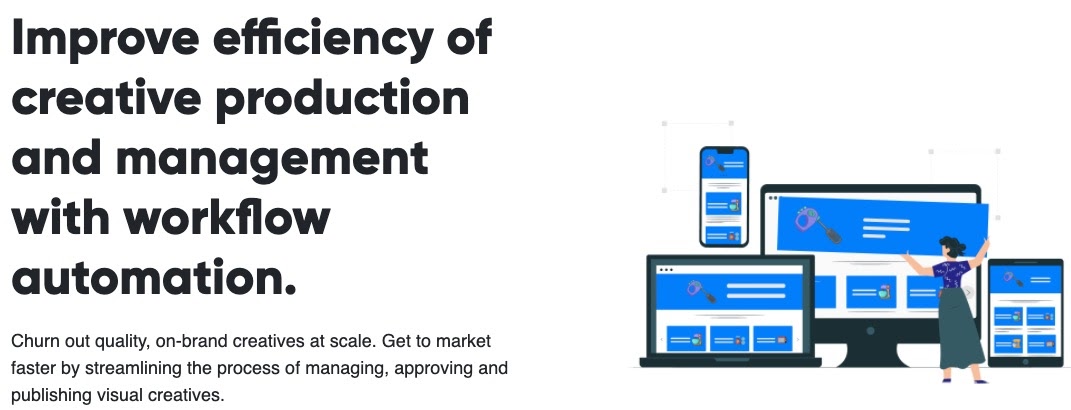
We’ve automated several of the manual steps that they would have done manually. Then we added machine learning or AI and automation steps at different key places so that those manual steps do not have to be done. And enhanced them further.
In all, we’ve made marketing teams more productive, much faster, and design teams can be much more productive and spend time on creative activities.
9. Your customers think the templates are wonderful. However, most of them feel it doesn’t allow modification and they have to try out different templates to choose which best suits their business model. Is there a reason you designed it that way, or are you still working on it?
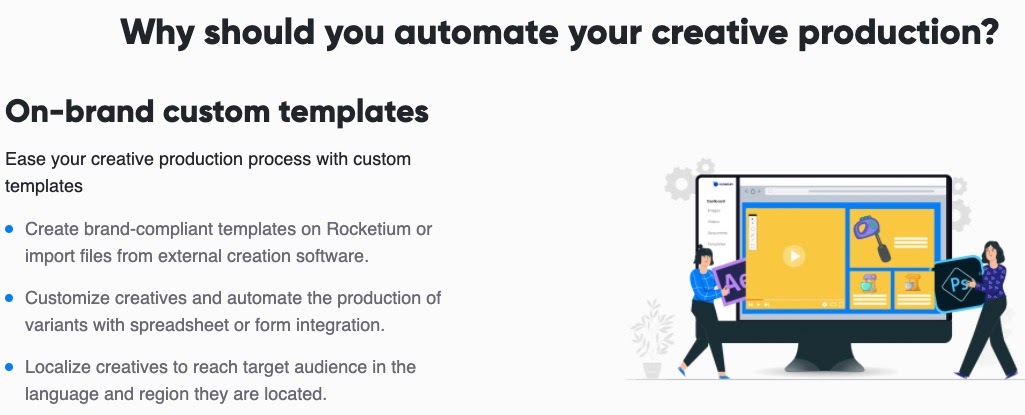
Well, Some of this feedback might be from our past product. When we were more of a B2C. The first three and a half years or so of our product where I talked about how we pivoted into the video business when we did that.
We were actually a more consumer-oriented product. Anybody could sign up on our website and make videos.
And at that time it was important for these customers to have a large repository of pre-made templates. And this is something that you would even see in a Canva.
Whereas Adobe software would not come with a lot for pre-made templates. Hardly any, because they are used by professionals.
On Canva, because it is designed for non-professionals and somebody who’s not very vast with design. They come with hundreds of thousands of templates.
So, Rocketium was more like Canva.

Today because we have moved to work with brands who have their own preset, creative guidelines, existing templates, and creatives.
We help them more with taking their existing designs and automatically adapting them into Rocketium format and one-click making templates out of it.
So, today the problem that we’re solving is not to give you hundreds of templates so that you can make things. Because these brands are established and already have a design language.
Instead, we’re saying that you can now decide to allow the end users to make changes after you make these templates.
If somebody is complaining that they can’t make changes. It’s probably because their administrators, designers who have made those templates have decided that, Hey, you can’t make these changes.
You can’t change the font or the colors or any of those. Those are locked elements. But if it is about our B2C product, that was a different era somewhere.
We’re happy to solve that segment and those customers. But somewhere we found that their scale of operations is not high enough.
Whereas in the case of automation, you want more templatized solutions without having to ma.
10. Are you building any new feature into Rocketium? Is there anything you’re working on at the moment?

Well, 2021 is looking like a very interesting year for us because we have always focused purely on the creative production side of things.
We’ve also said that this is a place where designers and marketers can come together, templatize content, make it at scale. Period.
What do they do with that? We never got into it. We were never opinionated about it. We didn’t really care where you take that content.
However, last year we started working with a lot of consumer internet startups, e-commerce companies and brands.
What we’re realizing is that there are two to three very common use cases. People are using Rocketium to make creatives that go into driving apps and any sort of advertising content that they’re making. They’re also using it to make in-app content.
As you’re scrolling through different apps, you’re seeing banners and videos within them. Either for the products themselves or any other sort of advertising that they are doing within their app itself.
And the third one is to bring back customers through push notifications. Saying, ‘these are items in your cart,’ or ‘these are new products we have launched’ or ‘here’s a discount for you.’ Things like that.
So across the board, we’re seeing that the need for Rocketium doesn’t end after you’ve given the creativity. Because after the creative is ready, especially today when we help you make content at scale. What happens once can give you 200 images, 500 videos, and so on.
Manually creating 500 ads or 500 push notifications is a lot of pain. So, we’re building ways to integrate with your ad platforms, with your marketing automation systems, with your e-commerce platforms.

So that the content you make in Rocketium can be pushed to those destinations with one click. You should be able to run your ad campaigns through Rocketium.
You should be able to
- Connect with your audience
- Send push notification campaigns, and
- Send out highly personalized notifications to customers online.
If you’re powering your content within your app to Rocketium, you should be able to make changes and publish within a few minutes. You should be able to send personalized live content to each person being delivered by Rocketium. Right?
So that would be a big shift from just producing the content to deploying it and making it available to them.
11. Okay! Very interesting. I see many things I like about Rocketium. But I’m just curious, is there something about Rocketium that is really powerful and useful, but you haven’t talked about it much and you would love to bring attention to that?
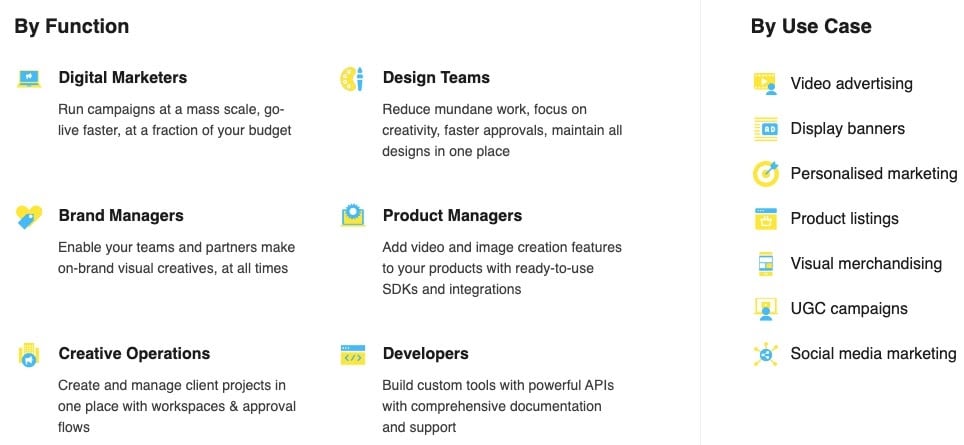
Yeah! Honestly, a lot of ideas that we have has been there pretty much from day one.
So even when we were doing a lot of the game-based services, we always had this idea of having a social angle to it. Where you could share all of this content, people could come and see your profile. So even today we keep thinking about it.
But maybe this year, maybe next year, sometime we’ll actually think more about it.
And one of those ideas is a marketplace. If you’re a designer or you’ve created a lot of usable elements for designers and marketers, then today, you don’t have a place to share it beyond platforms like Dribble. Where it’s more about showcasing the most spectacular things that you have done.
But at work, you’re not making that kind of content every day. You still have to take one banner, make it in 50 sizes. Take one video, make it for ten different products.

However, there are sparks of creativity where you might get 30% from a design, but never share that with anybody.
So today, even in software like Figma, you’ll see a thriving marketplace and community of people sharing and open-sourcing their ideas.
They are sharing their designs with the world. Today, if we’re a place where some of these larger companies, small businesses, or individuals are creating very interesting content. Why can’t they open that up to other people so that others can see it?
Like you mentioned earlier, small businesses are looking for ideas of how to do more effective marketing. And hundreds of thousands of people use Rocketium, including hundreds of large brands.
What if those brands can share their ideas and what has worked for them? you could reuse those ideas. You could make creatives that looked like those because this is not proprietary and hidden, right?
Because millions of people are seeing your ads. They’re seeing your ad content. So it’s not like it’s hidden. What if you could take what you’ve created and shared it with others.
So this marketplace is an idea that we have had in our heads for a long time, but maybe someday we’ll get around to it.
About Rocketium
Rocketium is an AI-powered creative management platform to build, iterate, collaborate and go live with marketing campaigns that help your business grow.
Since 2015, their product has helped businesses in over 95 countries with their marketing activities.
High performing marketing teams use Rocketium’s self-service tools to produce banners, gifs and videos at a mass scale, that are in turn used for marketing campaigns, site merchandising and internal communication.
Rocketium’s suite of products makes graphic design production fast and scalable with its self-serve design and development tools.
